Introduction
Crispy Shredded Potatoes, known in Chinese cuisine as 脆溜洋芋丝 (Cuì Liū Yángyù Sī), is a dish that marries simplicity with culinary finesse. This beloved recipe, rooted in Chinese home cooking, transforms humble potatoes into a golden, crispy masterpiece with a delightful balance of textures and flavors. The name itself hints at the dish’s essence: 脆 (crispy) and 溜 (a cooking technique involving quick stir-frying with a glossy sauce). While the ingredients are minimal, the technique demands precision—making it a favorite among both novice cooks and seasoned chefs. In this comprehensive guide, we’ll explore the history, key techniques, and detailed steps to recreate this dish in your kitchen, ensuring every shred of potato achieves that coveted crunch.
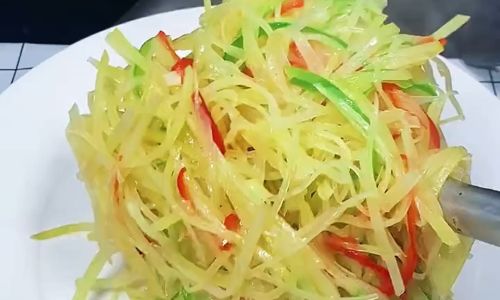
The Origins and Cultural Significance
The origins of 脆溜洋芋丝 can be traced to China’s Sichuan and Shandong provinces, where potato cultivation thrives. Potatoes, introduced to China in the 17th century, became a staple due to their versatility and resilience. Over centuries, creative cooks developed myriad ways to prepare them, with shredding and frying emerging as a popular method. The dish’s name reflects its cooking style: 溜 typically involves marinating, coating, and quickly stir-frying ingredients, often finished with a light sauce. Today, it’s a staple in Chinese households, street food stalls, and upscale restaurants alike, prized for its affordability and addictive texture.
Key Techniques for Perfect Crispiness
Achieving the ideal crispiness in shredded potatoes hinges on three factors: starch removal, uniform slicing, and temperature control.
- Starch Removal: Potatoes contain starch, which can lead to sogginess if not addressed. Soaking the shreds in water removes excess starch, ensuring a crisp finish.
- Uniform Slicing: Thin, evenly sized shreds cook uniformly, preventing some pieces from burning while others remain undercooked.
- Temperature Control: High heat sears the potatoes quickly, locking in moisture and creating a crunchy exterior while keeping the interior tender.
Ingredients You’ll Need
Before diving into the cooking process, gather these simple yet essential ingredients:
- Potatoes (500g): Opt for starchy varieties like Russet or Idaho for maximum crispiness.
- Vegetable Oil (100ml): Neutral oils like peanut or canola work best for high-heat frying.
- Vinegar (1 tbsp): Rice vinegar or apple cider vinegar adds a subtle tang.
- Salt (1 tsp): Adjust to taste.
- White Pepper (½ tsp, optional): Enhances the dish’s aroma.
- Cornstarch (2 tbsp): For coating the potatoes.
- Spring Onions (2 stalks): Finely chopped, for garnish.
- Chili Flakes (½ tsp, optional): For a hint of heat.
Step-by-Step Cooking Guide
Step 1: Preparing the Potatoes
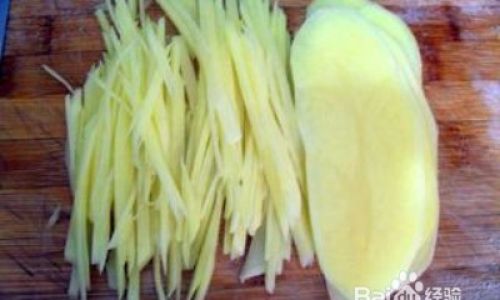
- Peel and Rinse: Wash the potatoes thoroughly, then peel them using a vegetable peeler. Remove any eyes or blemishes.
- Shred: Using a mandoline or sharp knife, slice the potatoes into thin, matchstick-like shreds (3mm thick). Aim for uniformity to ensure even cooking.
- Soak and Drain: Place the shreds in a large bowl of cold water. Swirl gently to release starch, then drain using a colander. Repeat this process 2–3 times until the water runs clear. Pat the shreds dry with a clean kitchen towel or paper towels.
Step 2: Coating the Potatoes
- Season: Transfer the dried potato shreds to a mixing bowl. Add salt, white pepper (if using), and chili flakes. Toss gently to distribute the seasonings.
- Cornstarch Dusting: Sprinkle cornstarch over the shreds. Use your hands to coat each piece evenly, ensuring no clumps form. The cornstarch will absorb residual moisture and create a light, crispy coating when fried.
Step 3: Frying the Potatoes
- Heat the Oil: Pour vegetable oil into a wok or deep skillet. Heat over medium-high flame until the oil reaches 180°C (350°F). Test the temperature by dropping a single potato shred into the oil—if it sizzles and floats immediately, the oil is ready.
- Fry in Batches: Add a handful of coated potato shreds to the hot oil, using tongs to separate any clumps. Fry for 2–3 minutes until golden and crispy. Avoid overcrowding the pan, as this lowers the oil temperature and results in soggy shreds.
- Drain Excess Oil: Use a slotted spoon to transfer the fried shreds to a plate lined with paper towels. Repeat until all potatoes are cooked.
Step 4: Preparing the Sauce (Optional)
While the classic 脆溜洋芋丝 is often enjoyed crispy and dry, some variations incorporate a light sauce for added complexity. To make this:
- Combine Ingredients: In a small bowl, mix 1 tbsp vinegar, 1 tbsp soy sauce, 1 tsp sugar, and 2 tbsp water.
- Heat the Wok: Pour out the frying oil, leaving 1 tbsp in the wok. Add minced garlic (1 clove) and ginger (1 tsp) and stir-fry for 30 seconds until fragrant.
- Toss the Potatoes: Add the fried potato shreds to the wok, followed by the sauce. Toss quickly to coat, ensuring the potatoes absorb the flavors without losing their crispiness.
Step 5: Final Touches and Serving
- Garnish: Sprinkle finely chopped spring onions over the potatoes just before serving. Their fresh, aromatic notes complement the dish’s richness.
- Serve Immediately: 脆溜洋芋丝 is best enjoyed piping hot, as the crispiness wanes slightly upon cooling. Pair it with steamed rice, congee, or as a standalone snack.
Troubleshooting Common Issues
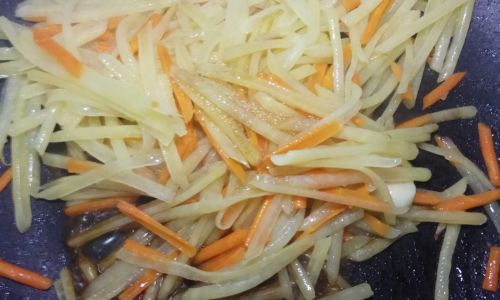
- Soggy Potatoes: This often results from insufficient starch removal or overcrowding the pan. Ensure thorough drying and fry in small batches.
- Uneven Cooking: Inconsistent shred thickness is the primary culprit. Invest in a mandoline for uniform slices.
- Burnt Flavor: High heat is crucial, but monitor the oil temperature. If smoking occurs, reduce the flame slightly.
Variations and Creative Twists
- Spicy Version: Double the chili flakes or add a dash of Sichuan peppercorn oil for a numbing heat.
- Vegetarian Upgrade: Toss in shredded carrots, bell peppers, or mushrooms during the frying process.
- Gluten-Free Option: Replace soy sauce with tamari or coconut aminos in the sauce.
The Science Behind the Crunch
The crispy texture of 脆溜洋芋丝 is a result of the Maillard reaction—a chemical process where amino acids and reducing sugars react under high heat, creating browned, crispy surfaces. By removing starch (a carbohydrate), the potatoes’ natural sugars concentrate, enhancing the Maillard effect during frying. The cornstarch coating acts as a barrier, preventing moisture loss and ensuring a sustained crunch.
Cultural Adaptations Around the World
While 脆溜洋芋丝 is deeply rooted in Chinese cuisine, similar dishes exist globally. In Korea, (Gamja Matang) features caramelized potato chunks, while Belgium’s frites (fries) prioritize a fluffy interior. However, the Chinese method’s emphasis on ultra-thin shreds and rapid frying sets it apart, offering a texture that’s both delicate and intensely crisp.
Conclusion
脆溜洋芋丝 is more than a dish—it’s a testament to the magic of simplicity. With just potatoes, oil, and a handful of seasonings, you can create a culinary marvel that delights the senses. The key lies in mastering the techniques: starch removal, uniform slicing, and precise frying. Whether served as a side dish, appetizer, or snack, this recipe guarantees a crispy, flavorful experience that transcends cultural boundaries. So grab your wok, sharpen your knife, and embark on a journey to recreate this iconic Chinese classic in your own kitchen. Your taste buds—and your dinner guests—will thank you.
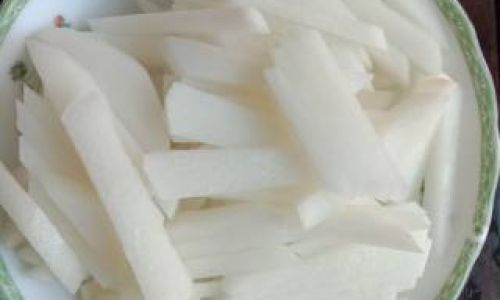
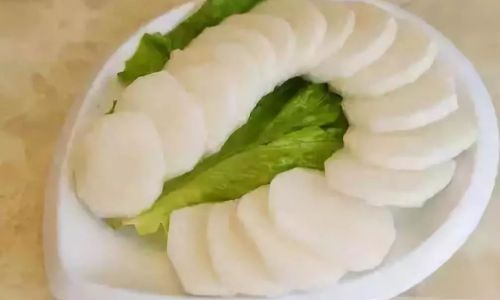
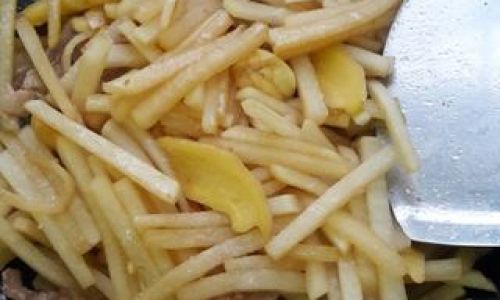
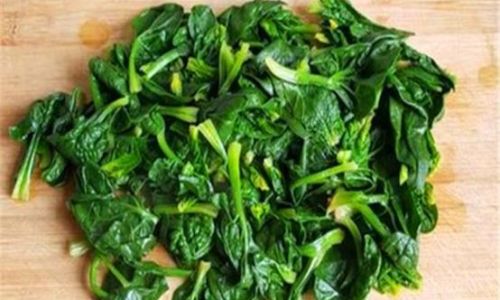
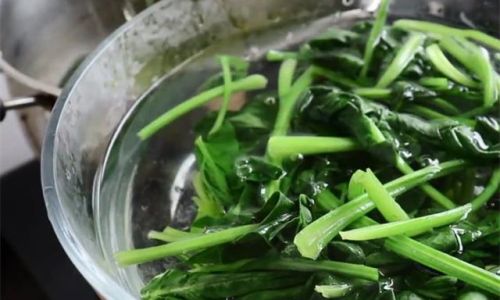
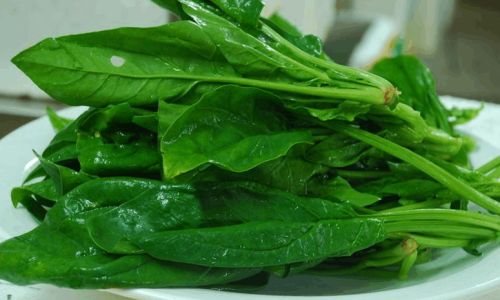
0 comments